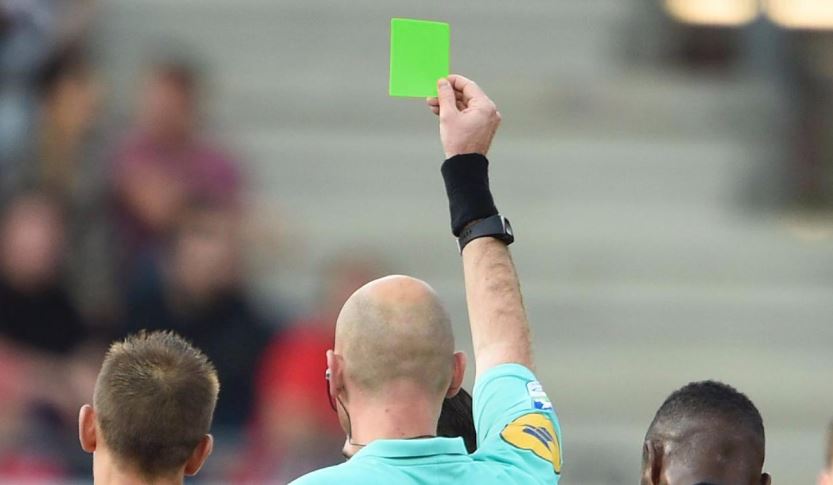“A green card in soccer is a rare occurrence, unlike yellow or red cards and Its meaning varies by league. In some leagues, like Italy’s Serie B, it’s given for exceptional sportsmanship, like admitting a foul or aiding an injured opponent.
In other cases, like the 2018 CONIFA World Cup, it’s a temporary disciplinary measure. Players who get a green card must leave the field but can be replaced if substitutions are available.”
READ ALSO: Top 10 Richest African Soccer Players
Difference Between Green, Yellow, And Red Cards In Soccer
In soccer, green, yellow, and red cards are used by referees to enforce rules and maintain fair play. Green cards are not commonly used in professional soccer. They may be used in youth or amateur games as a positive reinforcement for good behavior.
Green cards can encourage players to display sportsmanship and fair play on the field. Yellow cards are issued as a caution to players who commit fouls or misconduct. When a player receives a yellow card, it is a warning that their behavior is unacceptable.
If a player receives two yellow cards in the same game, they are shown a red card and must leave the field. Yellow cards can also accumulate over multiple games, leading to suspensions for players who reach a certain number within a specified timeframe.
Red cards are the most severe punishment in soccer. They are shown to players who commit serious fouls or acts of misconduct. When a player receives a red card, they are immediately sent off the field and cannot be replaced by a substitute.
The team must continue the game with one fewer player, putting them at a disadvantage. Red cards often result in additional disciplinary measures, such as fines or suspensions, depending on the severity of the offense.
Some Matches Where Green Card Has Been Issued In Soccer
The green card in soccer, introduced during the Conifa World Cup, fills a space between yellow and red cards. At this tournament, it was shown twice by referee Raymond Mashamba during the Padania vs. Tuvala match in London.
In this competition for nations not affiliated with FIFA, the green card carries specific rules: a player receiving it must exit immediately but can be substituted if substitutes remain unused, and they aren’t excluded from the next match.
While this was the first time the green card was used in a disciplinary context, it has previously been employed in Italy’s Serie B for acts of fair play. Moreover, it’s been utilized in grassroots soccer in Ireland to encourage sportsmanship.
However, there are no plans to introduce the green card at major tournaments like the upcoming World Cup or in professional English football leagues. Meanwhile, Powerplay Ontario provides options where you can bet on any of the other cards to be brandished to a player during a game.
This invention aims to address situations falling between a warning (yellow card) and expulsion (red card), promoting fair play while avoiding harsh penalties. Its limited use suggests it’s still an experimental concept rather than a widespread practice in soccer regulation.
READ ALSO: Top 10 Cameroon Soccer Players Of All Time
Is The Green Card A Good Idea For Soccer?
The green card in soccer has been a topic of discussion in recent years. However, the idea is that players who receive a green card are recognized for their positive behavior, like helping an opponent who is injured or showing respect to the referee.
Whether a green card is a good idea for soccer depends on various factors. Some argue that it encourages players to behave better and can help create a more positive atmosphere during games.
Others are concerned that it may be seen as a form of “soft punishment” and could detract from the intensity of the game. In terms of data, there isn’t a wealth of statistical evidence specifically regarding the impact of green cards on soccer matches.
Based on a rumor from leagues that have implemented the system suggests that it can have a positive effect on player behavior. For example, in the Italian Serie B, where the green card system was introduced in 2016, there was a noticeable decrease in disciplinary incidents during matches.
This tells that players may be more mindful of their actions knowing that they could be rewarded for positive behavior. Also, in the United States, where the green card system has been trialed in some youth soccer leagues, coaches and officials have reported a positive response from players.
Many believe that it helps instill values of respect and fair play from a young age. If you ask me, while the green card may not be a perfect solution to all the challenges of soccer, it does seem to have some merit in promoting sportsmanship and fair play.
READ ALSO: Top 10 African Coaches In Europe With UEFA Pro License
What Are Some Examples Of Fair Play That Earn A Green Card?
● Helping An Injured Opponent
When a player notices an opponent injured, they can pause the game by kicking the ball out of play. This gesture allows the injured player to receive medical attention right away.
● Admitting A Foul
Sometimes players unintentionally commit fouls. If a player realizes they’ve fouled an opponent, they can acknowledge it to the referee.
● Assisting The Referee
Players can assist the referee by alerting them to potential fouls or violations that they may have missed.
READ ALSO: Top 10 Highest-Paid African Footballers Playing In Africa
● Respecting Officials’ Decisions
Accepting the decisions of referees without argument shows respect for authority and upholds the spirit of fair play. Players can express disagreement respectfully without undermining the referee’s authority.
● Fair Challenges
Engaging in fair and competitive challenges for the ball without resorting to reckless or dangerous tackles is essential for fair play.
